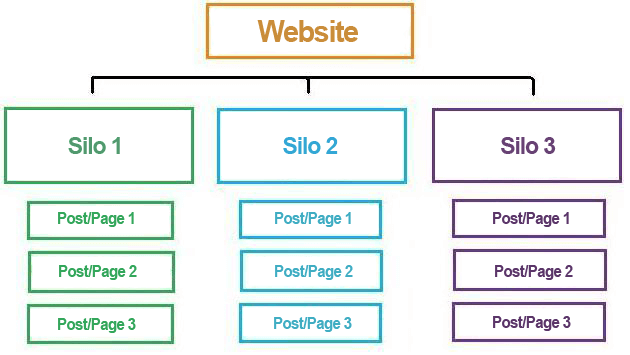Content Silos SEO
 Before you look at your web pages and your current internal links, let’s get an overview of what a content silo is. A content silo architecture is the idea of grouping related content together. This helps to identify the central theme your website is targeting and improve the visibility of your content for search engines.
Before you look at your web pages and your current internal links, let’s get an overview of what a content silo is. A content silo architecture is the idea of grouping related content together. This helps to identify the central theme your website is targeting and improve the visibility of your content for search engines.
Why use a content silo structure?
A content silo structure makes it easier for search engines to deliver relevant content. Content is more organised and focused and has improved chance of satisfying the user’s search query. Content silos may improve your authority for the topic of your website.
Example of Content Silos

Planning a Website Silo Architecture
When it comes to planning a website silo, there is a lot of steps to take into consideration. Here are 4 steps to help you get started.
Step 1
Determine or identify the theme of your website. To help you determine the theme of your website, attempt to do the following.
- Establish a list of high search volume keywordsyour website ranking for.
- Identify keywords that are relevant to your website.
- Use the top search queries users are searching for to find your content.
- Implement a clear theme or subject for your website.
Step 2
Create a virtual silo where you focus on internal links that enhance the theme of your website.
Step 3
Create link structures that apply links between pages which re-enforce your website’s theme.
Step 4
Publish content that is of high quality. The content should include high and low search volume keywords. Make sure the topics of your content fit in with your content silo plans.
Internal Linking Structures
Internal linking is not about numbers. With Google’s algorithm of today, it is all about placing links in the right place. Internal links need to serve a purpose.
When it comes to internal links in a silo structure, you will want to keep within your category. For example, if you are managing an online shoe store, your main categories may include, Kids, Ladies, Mens. Under each section may have your different shoe brands. In this instance, you will not want to link to ladies puma shoes from the men’s shoe page.
URLs that contain parent pages should not link outside of their silo or category. Parent pages should also link to other parent pages. Remember, you do not want to link to the home page from your parent pages or main pages, as this can create keyword cannibalisation.
Content Silo Linking Strategy
Anchor Texts
When it comes to anchor texts, use keywords that have high search volumes. Choose appropriate keywords that suit the content and link. This will help improve keyword rankings as well as improve your chances of reaching your targeted audience.
Internal Linking
Internal links help you build on the theme of your website. When it comes to header links, it is important to arrange header menu links to resemble the main categories of your silo plan. These header links should include the main topics of your website. Our top tip is not to link to secondary pages from the header menu. Keep these link to use within the content on the appropriate pages. Keep your internal links within your silo plan.
When you find instances where you are linking to pages outside of your silo plan, it may result in a loss of link value. To prevent this, you can use the rel=”nofollow”. However, we recommend not to over use this option.
Siloing Content Tips
- Identify web pages with the most internal links.
- Use a silo to identify new linking opportunities.
- Implement internal links with the best anchor texts to link to other pages within the same silo category.
Website Content Silo Benefits
- Increased ranking power – Gives more authority to your website about a particular topic or theme.
- Makes finding content much easier as everything it grouped together.
- Good for SEO and user-experience.

Summary
- Create categories of content (keep to as few categories as possible, the average is 5 – this will depend on how big your site is).
- Arrange your content by similarities
- Link parent pages and articles.
- Use relevant keywords with high search volumes are your anchor text.
- Blogs do not classify as a category as they do not form part of a content silo. Blogs use a flat structure which is why they do not form part of a content silo.


